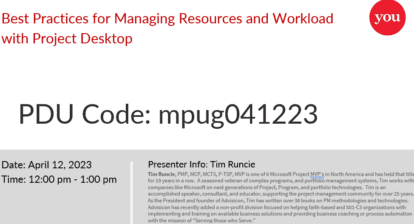A growing number of managers rely on project and portfolio management to help them oversee their investment portfolio. As a consequence of this reliance, many have also discovered that their organizations’ current financial management practices fall short of intended goals. Results of a survey UMT conducted in September 2010 with leading U.S. companies indicated that almost 80 percent of those polled felt some level of dissatisfaction with their current financial management methods. Primary obstacles, according to the respondents, include knowledge deficiencies, lack of management support, and use of ineffective software.
Many managers fail to fully understand the impact of poor financial management. They believe that the majority of investments don’t require financial evaluation — that intangible benefits provide an acceptable metric for success. This can prove to be a costly mistake, resulting in a poor track record of project selection and mismanagement of company investments.
Further complicating matters are CEOs, CFOs, and corporate trustees, who face a litany of economic challenges and expanding compliance requirements, finding themselves under extreme scrutiny as to how they should allocate their resources. As a result, they’re increasingly demanding credible evidence of strong and achievable return on investment (ROI) before assigning dollars to projects.
Managers and executives alike would best be served by establishing strong project financial management (PFM). But what type of PFM offers the most benefits We believe it’s project financial intelligence or PFI.
This article defines PFI and its importance in project selection and investment management. I also explore the cost of PFI illiteracy and the benefits that can be derived from the use of PFI. With a more detailed understanding of PFI, managers can better address their needs to finance the right opportunities and wisely manage their investments. I conclude with recommendations on how to move forward.
Project Financial Intelligence (PFI) Explained
PFI integrates three disciplines: project management, financial management, and business intelligence (BI). This integration provides valuable insight into project financials that can significantly improve decision making and visibility throughout the project lifecycle. PFI focuses on the details of cost and benefits, with information that’s thorough, logical, and defensible. PFI also provides insight into decisions. In addition, PFI integrates project and business domains and helps to improve governance.
The Importance of PFI
Management expert Gary Hamel points out that over the course of the past century, management innovation, more than any other kind of innovation, has enabled companies to cross new performance thresholds. If you look closely at some of America’s leading companies — GE, DuPont, Procter & Gamble, and Visa — you would find management innovation at the core of their success. Interestingly, according to Hamel, almost all of the 20th century’s most significant management innovations — strategic planning, capital budgeting, project management, cost accounting and variance analysis, and ROI analysis — all fall within the PFI classification.
PFI affects most key economic organizational transactions, including capital appropriation, capital spending, tracking, investment justification, cash flow management, funding, resource allocation, and chargeback. Considering that capital spending in the United States equals about $1.38 trillion, companies could use PFI to better manage their business investments in projects and create a durable advantage that can impact the competitive position.
The Price of PFI illiteracy
The Standish Group’s “CHAOS Summary 2009” report revealed that about a third of all projects have successful resolutions. They’re delivered on time, on budget, and with required features and functions. What that means is that IT organizations within American companies and public entities spent $136 billion out of a total of $200 billion on failed projects or projects with unforeseen challenges.
The CHAOS report also shows a direct correlation between budget and success. For example, whereas projects costing between $1 million and $3 million succeeded 38 percent of the time, projects that cost more than $10 million had only a two percent success rate. This correlation between rising cost and lower success rate provides a clear example of how flawed financial management contributes to the failure of so many projects. With the proper use of PFI, organizations have a much better chance of selecting optimum projects and realizing their anticipated benefits.
The Benefits of PFI
PFI offers a valuable tool for many different aspects of strategic and operations management: project selection and management, operations budgeting and tracking, and governance. The following sections illustrate how managers can best use PFI in these scenarios.
Improving Project and Portfolio Decisions
A leadership team receives hundreds of project proposals to fill certain strategic or tactical gaps. Because of limited budget and resources, the team can only choose a select few. How does it create the optimal portfolio from the available options? The first step is to incorporate PFI into the process. Effective PFI drives action to approve, reject, or delay a project. To best utilize PFI, the team should consider the following course of action:
- Develop project estimates top down or bottom up.
- Assign cost and benefits to cost and profit centers.
- Create financial metrics such as net present value or ROI.
- Link strategic benefits to financials.
- Optimize investments based on financial and strategic benefits.
Once managers receive approval on a project, they can move their project into the execution phase. During this stage, businesses need to introduce performance controls to ensure the timeliness of a project’s completion, to deliver the project within budget, and to maintain financial and other data about the project’s benefits.
Performance controls continue to the project’s conclusion. At each review phase, occurring monthly, quarterly, or in stages, the leadership team can analyze performance. This analysis helps identify at-risk projects and their root causes and evaluates trends and predictions that assess business impact. Based on this information, plans can be revised and action taken to rectify any issues.
Aligning Project and Business Accounting
More and more organizations today follow a philosophy that encourages resource sharing. For example, a company may seek to share IT or marketing and capital investments. Sharing resources however, creates two large challenges: resource allocation and chargeback.
For resource allocation, organizations need to find a way of transferring the cost of shared resources from the unit that formally manages them to the one that consumes their services. The chargeback mechanism acts as a horizontal link between different organizational budgets in the company, keeping profit plans accurate and driving accountability.
PFI serves as the key enabler of the chargeback process. Benefits include:
- Providing input for fair resource allocation.
- Enabling the business unit that consumes the services to choose between internal or external sources.
- Offering insight into the resources consumed on a periodic basis.
- Providing the cost basis for enabling the business unit that supplies the services to charge the business unit that consumes the services.
Finally, with PFI, the organization that consumes the resources can use the chargeback bill to decide whether it still values the project benefits, if it wants to move faster and invest more, or if it should shop around to find other providers. In this way, the “consumer” can choose to get the level of investment most valued. Meanwhile, the provider aligns its services with what those consumers most want.
Enabling Better Governance
A flood of corporate scandals combined with the recent harsh economic downturn have served to undermine the confidence in current management systems and controls. Despite the fact that information assets represent more than half of capital spending, most companies lack effective financial governance.
Governance strives to promote individual creativity within defined limits of freedom by using structural and control safeguards. Structural safeguards ensure clear definition of authority for individuals handling budgets, processes, and workflows and effective standards for managing cost and benefits. In recent years, auditing has been added to this category as well.
Control safeguards measure and ensure compliance and process effectiveness. Financial compliance measures the deviation from agreed rules, practices, and standards. PFI uses the project information to drive three groups of measurements: exceptions from rules, project commitment deviations, and process effectiveness.
A Wake-Up Call
This article is meant to serve as a wakeup call to managers that perform project and portfolio management. As such, managers will need to approach PFI implementation systematically with an action plan, a methodology, and the understanding of the required information technology.
Management teams need to:
- Take the time to assess their current situation.
- Identify the processes that use PFI and assess their criticality and capabilities.
- Determine the gaps between current realities and needs.
- Consider the order in which to close them.
- When ready to move forward, create a timeline for action.
Equally important is the project financial software that can significantly affect the analytical and collaboration capabilities. Companies can use this software to take complex data and transform it into intuitive information and visuals. When properly deployed, this software can create useful collaborative environments to define workflows, deploy rules, and ensure that those rules are followed. Over time the companies that master PFI and the tools will come out ahead.
While PFI isn’t perfect, it’s a huge improvement over unreliable alternatives. The combination of people and computational power presents unlimited opportunities. The quality of the project financials depends upon the sum of all project and portfolio financial decisions made by decision makers. The good news is that the quality of these decisions depends not only on the intelligence of the decision makers, but on project financial processes and methodology that can be improved and successfully deployed in your organization.






